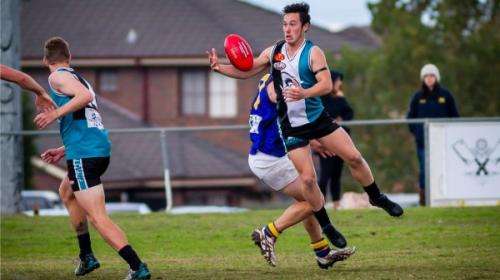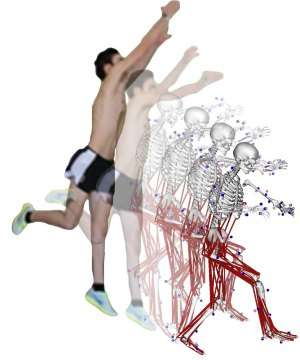Calf muscles outclass hamstrings in injury prevention

Better prevention of non-contact anterior cruciate ligament (ACL) injuries is on the horizon after a recent study found the calf muscle plays a larger role in stabilising the knee than previously thought.
Researchers from the University of Western Australia's School of Sport Science, Exercise and Health and the University of Tennessee studied six amateur Western Australian Rules footballers to determine what muscle forces are at work during single-leg jump landings.
Each footballer performed two single-leg jump landings on their preferred leg, while grabbing at a football.
Researchers filmed the jumps, using a 12-camera motion capture system to create three-dimensional footage, which they then used to create a 37 degree-of-freedom, full-body musculoskeletal model, scaled to each participant's anthropometry.
UWA Assistant Professor Cyril Donnelly says analysis of the model shows the calf—or gastrocnemius—muscle is used much more than the hamstring muscle during single-leg landings.
"This was initially surprising as 30 years of clinical research has suggested the hamstring muscles were key players for supporting the knee during sporting tasks," he says.
"We are not saying you don't use your hamstrings, just not as much as we originally thought."
Training to reduce risk of injury in sport
Increased force through the calf helped minimise external forces through the ACL, Asst Prof Donnelly says.

"When you think of this logically, these results actually make sense. The primary task of your neuromuscular system is to keep your body upright, or prevent it from falling to the ground.
"As the gastrocnemius are a bi-articular muscle [crossing two joints: the ankle and knee], they serve a secondary role to elevate joint compression and stabilise the knee.
"We feel this is the protective mechanism supporting the knee and protecting the ACL from injury during single-leg landing tasks."
In the United States over 400,000 ACL injuries occur annually, the majority from non-contact sports.
Asst Prof Donnelly says the model has provided a mechanistic understanding of why neuromuscular training of muscles like the calf may have reduced knee injuries in the past.
"Having the ability to estimate muscles forces during [single-leg landing and change of direction tasks] gives researchers and clinicians a better understanding of how to train the neuromuscular system to reduce an athlete's risk of injury in sport," he says.
"The downstream effect is the design of effective prophylactic training protocols to reduce an athlete's risk of injury in sport, and seeing injury rates reduced in Australia and around the world."















